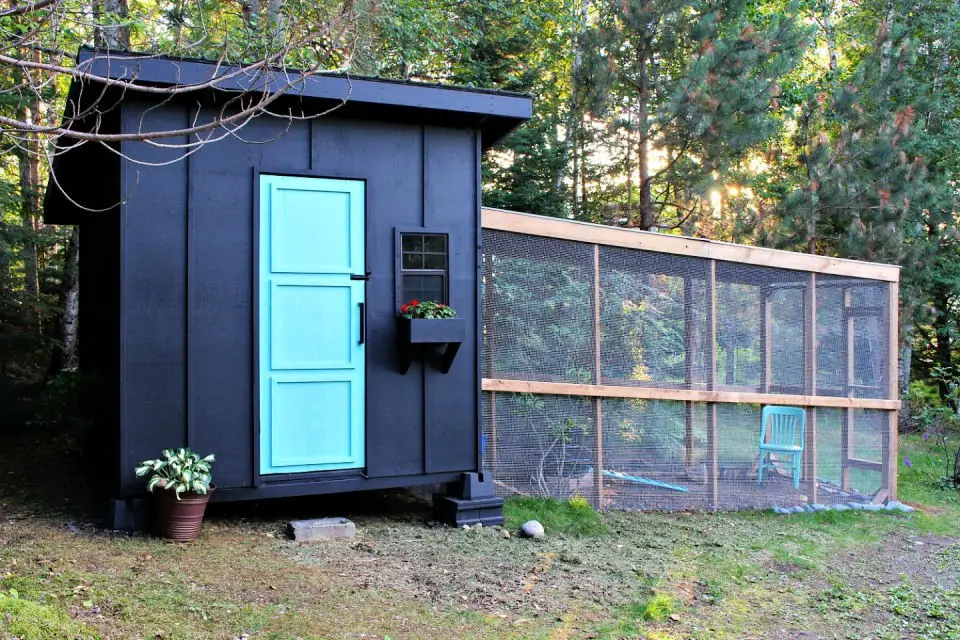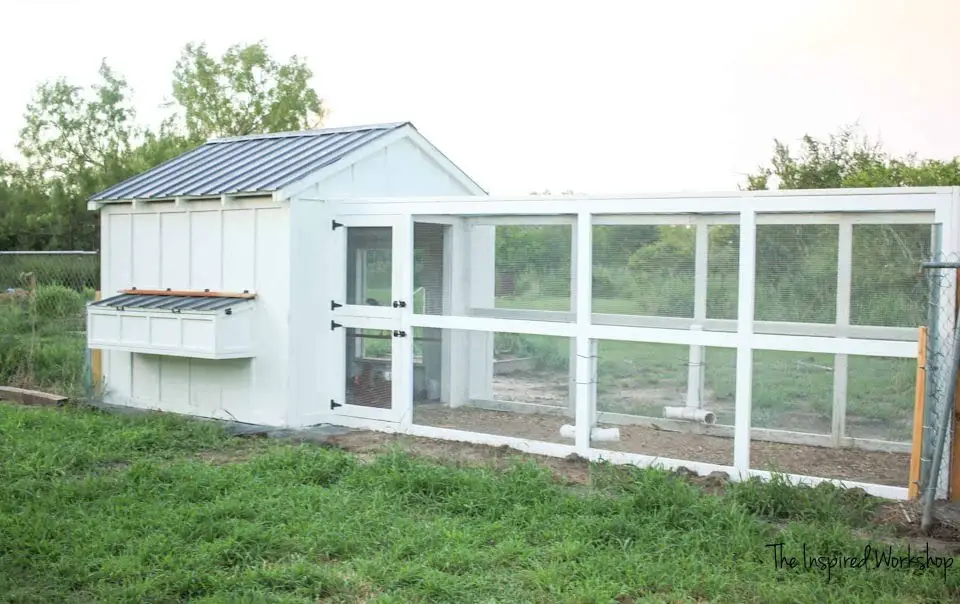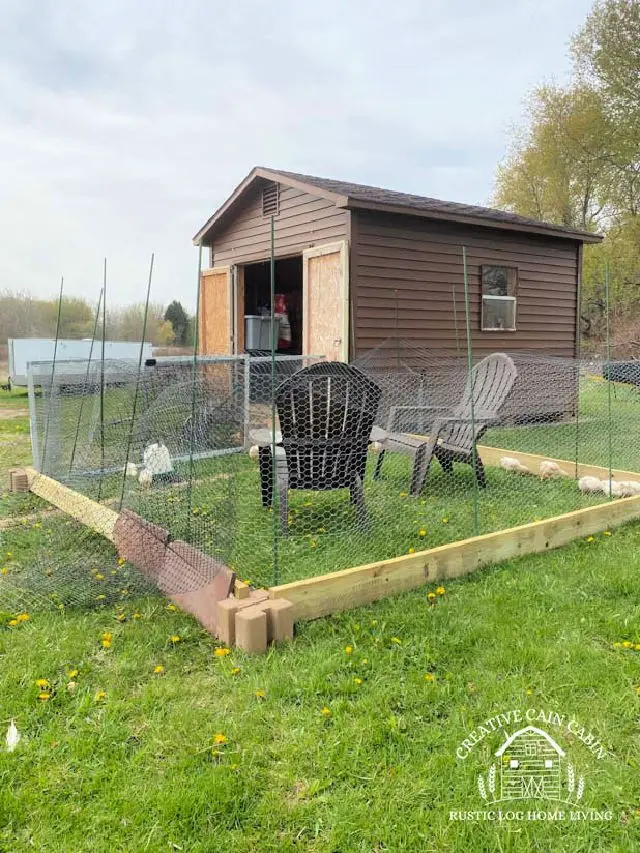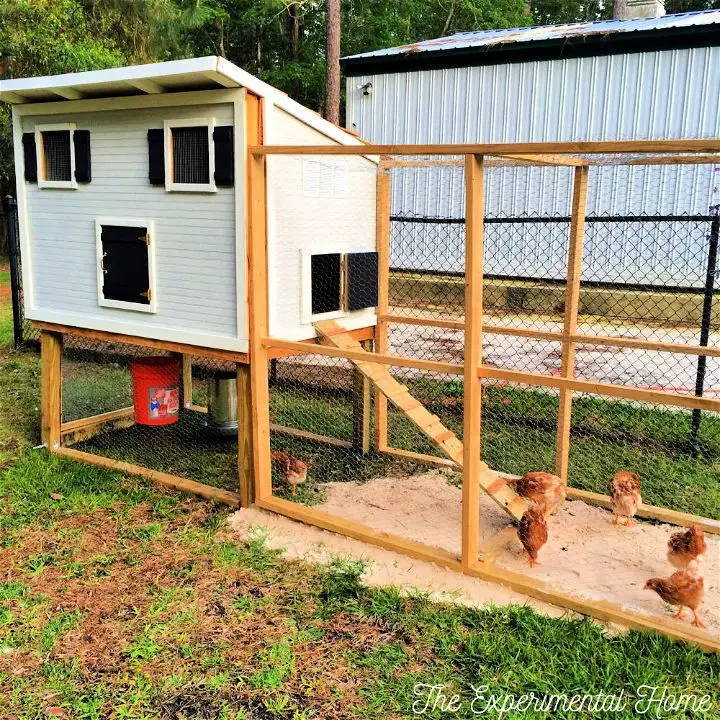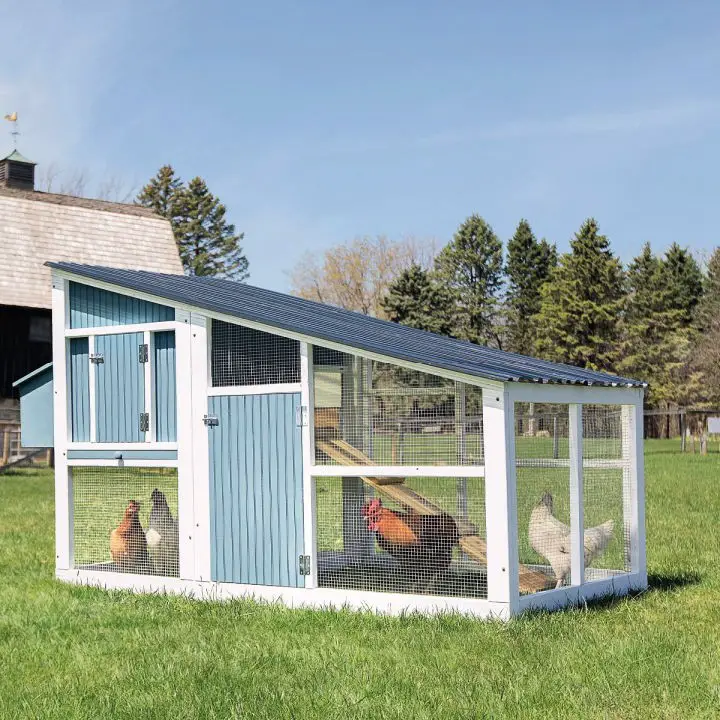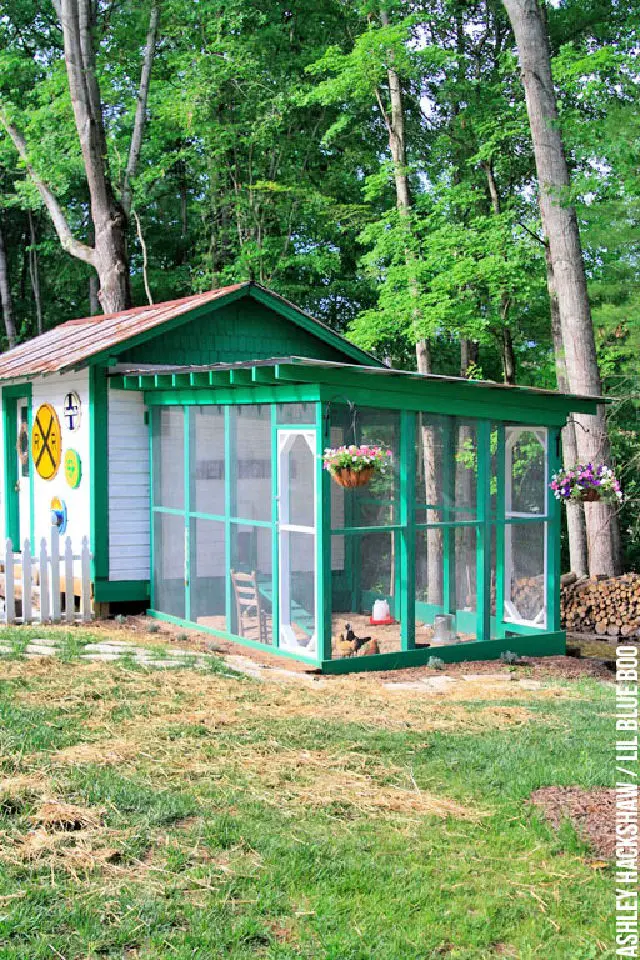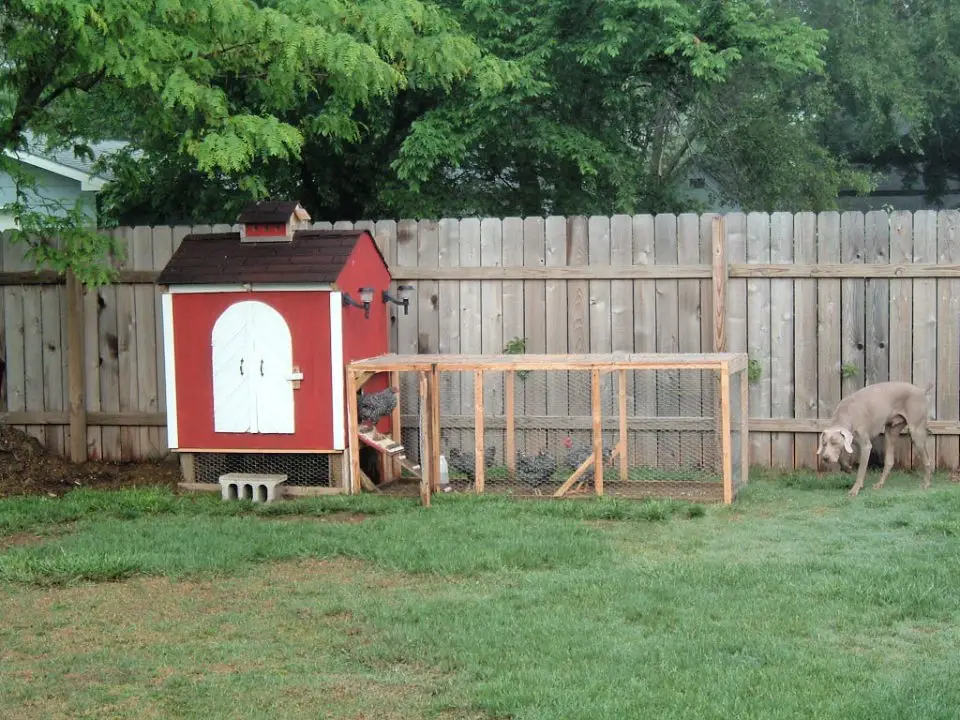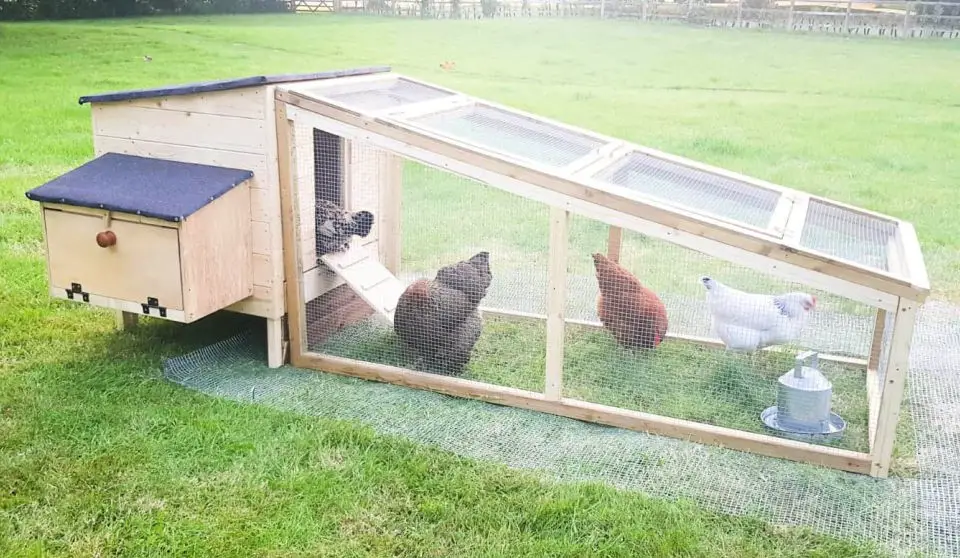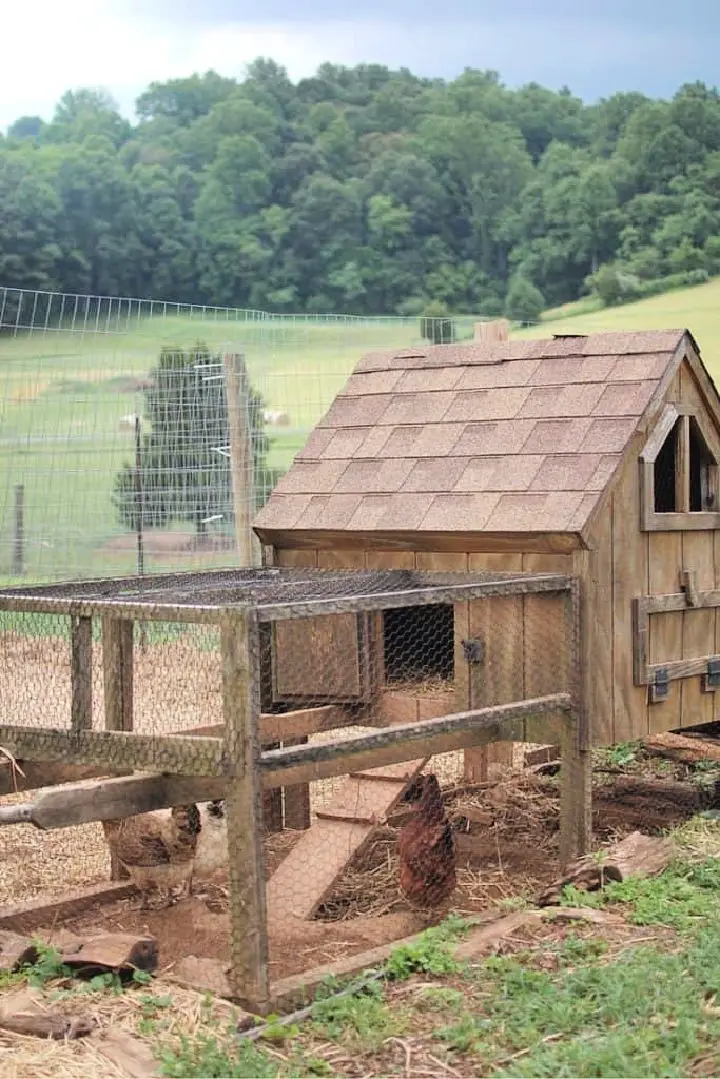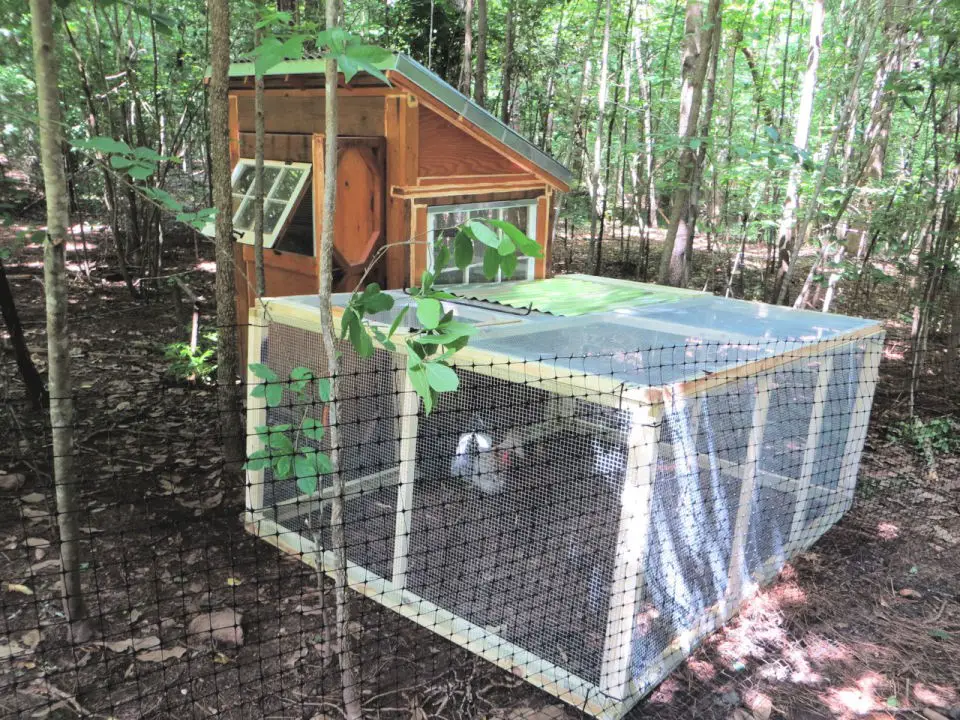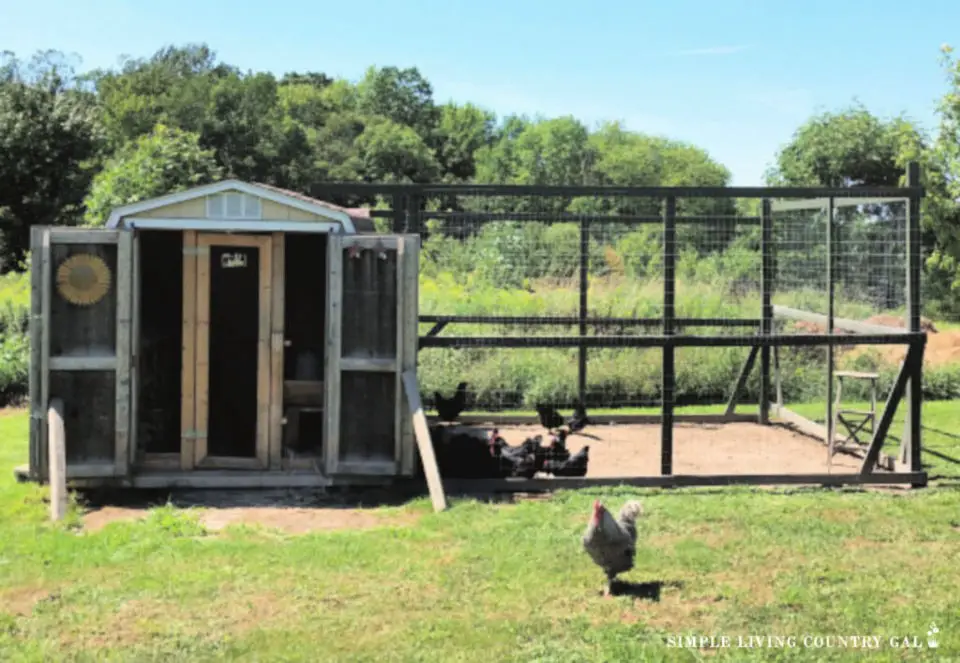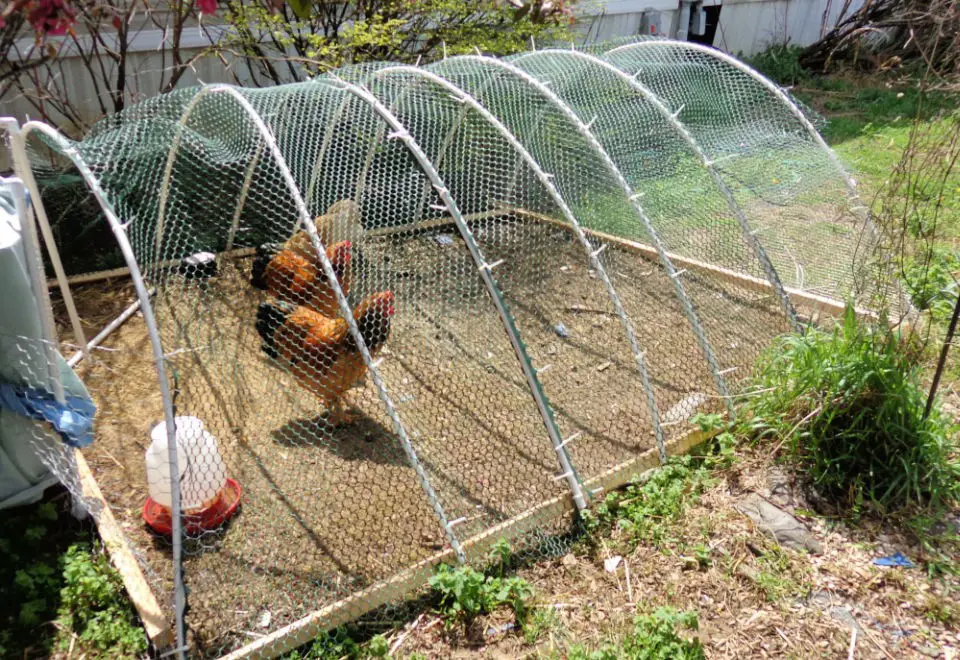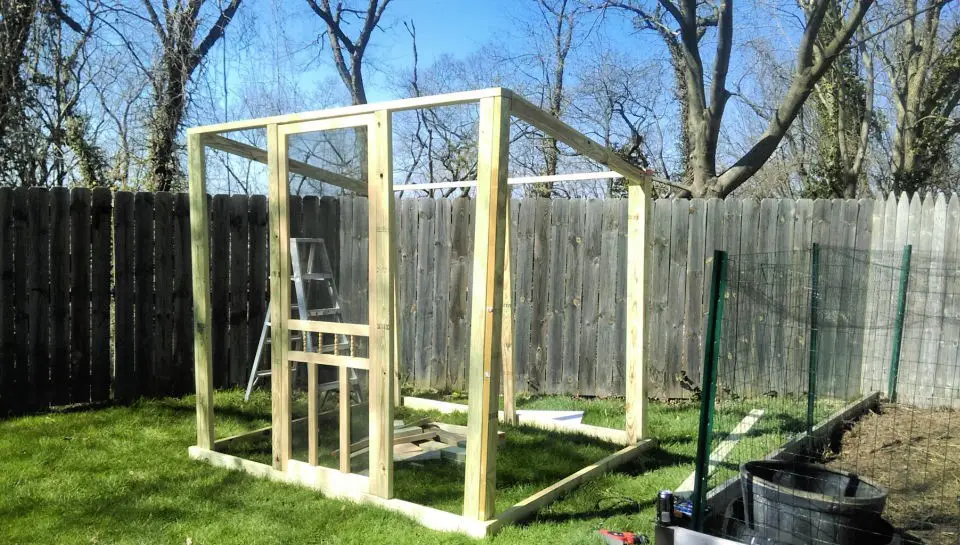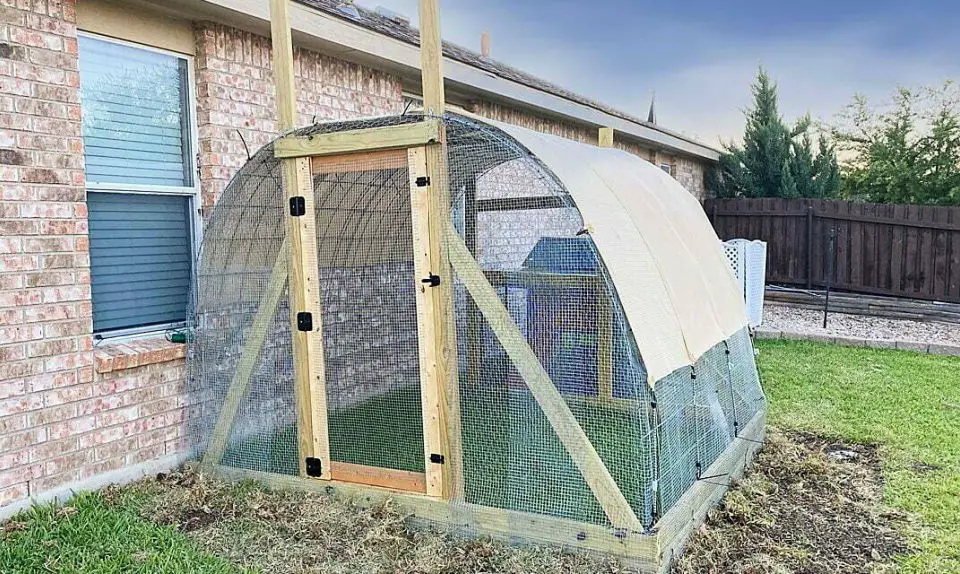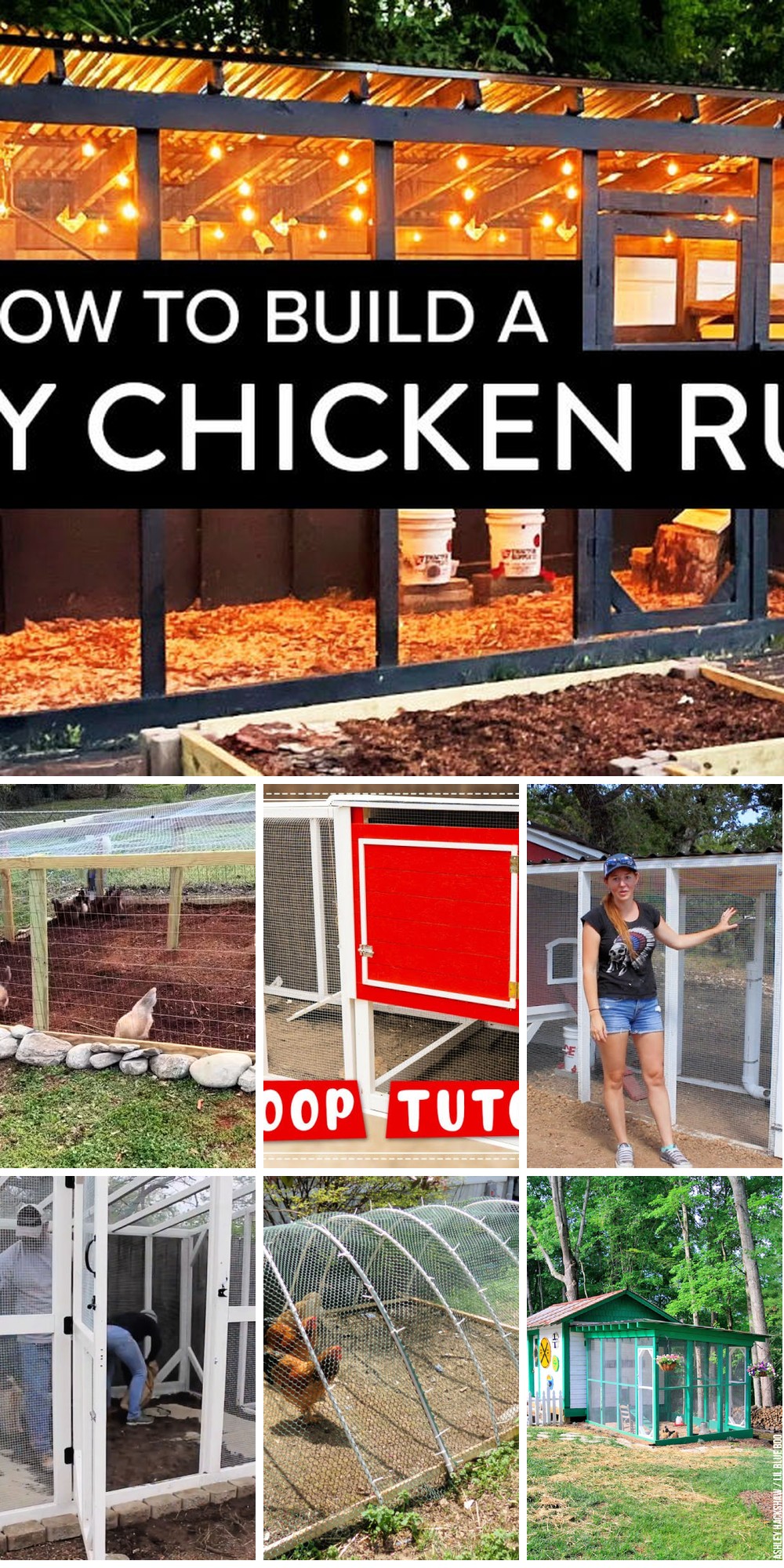
If you’re eager to create a DIY chicken run but aren’t sure where to begin, this comprehensive guide is here to help. We’ll walk you through 25 unique and customizable plans, providing step-by-step instructions to suit your specific needs. From identifying the perfect spot for your run to gathering all necessary materials, we’ve got every aspect of the process covered. Our goal is to deliver clear, engaging, and informative content that simplifies the project, making it accessible regardless of your DIY experience level. By following our simple yet effective DIY chicken run instructions, you’ll not only provide a safe haven for your chickens but also create a beautiful outdoor feature that complements your yard. Let’s dive into choosing the ideal location, constructing a sturdy frame, and adding those crucial finishing touches that make all the difference. Get ready to elevate your backyard with a practical yet charming DIY chicken run that your feathered friends will love.
Why Build a DIY Chicken Run?
Constructing a DIY chicken run offers a multitude of benefits, both for your feathered friends and yourself. This project’s advantages are multifaceted, encompassing safety, health, happiness, pest control, fertilization, and enjoyment. From the outset, a well-designed run ensures the security of your flock by shielding them from predators and potential hazards. Strong materials and proper construction techniques guarantee their wellbeing is paramount. Chickens require space to roam, forage, and exhibit natural behaviors; a spacious run allows them to do so safely, leading to healthier, happier birds with improved egg production and overall health. Moreover, chickens are natural foragers that feed on pests like ticks, beetles, and other insects, helping to keep your garden and yard pest-free in a sustainable manner. As they scratch and peck at the ground, their droppings also fertilize it, enhancing soil quality over time. Beyond its functional value, building a chicken run is a fulfilling DIY project that yields a sense of accomplishment and offers an educational experience for children, teaching them about animal care, responsibility, and basic construction principles.
Planning Your DIY Chicken Run: A Step-by-Step Guide
Enriching Your Backyard with a DIY Chicken Run, a Rewarding Project for Both You and Your Fowl Friends. A thoughtful DIY chicken run project not only elevates your backyard’s appeal but also significantly improves the quality of life for your feathered companions.
How Many Chickens? (Space Requirements)
When it comes to allocating space for your flock, a general rule of thumb is to provide at least 10 square feet per chicken to allow them to move around comfortably, search for food and engage in their natural behaviors. However, for the happiest and healthiest chickens, you may want to consider providing an ideal 15-20 square feet per bird. This extra space can significantly minimize stress and alleviate behavioral issues. It’s also crucial to verify local regulations regarding chicken run size and maximum bird numbers to ensure your setup complies with these requirements.
Where Should I Put It? (Location Considerations)
When designing a chicken run, it’s essential to strike a balance between sun and shade. Morning sunlight followed by afternoon shade creates an ideal environment for your flock. If this isn’t possible, consider incorporating artificial shading structures to ensure your chickens remain comfortable. The right drainage is also crucial – opt for a spot with a slight slope to prevent water accumulation and maintain a dry, healthy space for your birds. For added safety, prioritize a direct path between the coop and run, or secure the area with a predator-deterrent barrier if that’s not feasible. Finally, consider how you can leverage visibility from your house to deter predators and implement natural or artificial overhead protection against bird-of-prey threats.
What’s Your Budget? (Material Costs)
When it comes to building a coop, knowing what materials you’ll need is crucial. Start by considering the fundamental components: lumber, wire mesh, and roofing. Lumber prices can fluctuate, so be sure to get updated quotes on the posts, frames, and decorative elements you’ll require. Wire mesh, while potentially more expensive than chicken wire, offers better protection against predators. Calculate the square footage of coverage you’ll need to ensure you have enough. Roofing options include corrugated metal, clear panels, or tarps, each with its own unique price point. Choose your material based on your budget and personal preference for aesthetics. Don’t forget about the smaller items that can make a big difference: latches, hinges, screws, and treatments for weatherproofing.
Is This the Right DIY for You? (Skill Assessment)
Building a chicken run is an accessible project for those with basic construction skills, such as measuring, cutting, and assembling structures. For more complex projects like predator-proofing or constructing roof trusses, it’s recommended to seek additional expertise or assistance. Before commencing the build, take time to plan carefully, double-check your measurements, and cut materials accurately. Additionally, prioritize both safety and the enjoyment of your chickens by ensuring the enclosure is secure, spacious, and well-ventilated.
Predator-Proofing Essentials for Your DIY Chicken Run
To safeguard your flock’s health and happiness, it is vital to ensure that your chicken run is impenetrable to predators. In this section, we’ll delve into the most effective methods for constructing a predator-proof enclosure. By prioritizing robust foundations, unyielding walls, secure roofing, and trusty locking mechanisms, you can rest assured that your chickens are protected from external threats.
Secure Base
To keep digging predators at bay, consider employing a trifecta of deterrents: burying wire mesh, installing concrete footings, and designing an apron for your chicken run’s perimeter. Burying hardware cloth or wire mesh extending at least 12 inches below ground level will thwart attempts by foxes, dogs, and other would-be diggers from burrowing their way into the enclosure. For added security, pour concrete along the edges of the run to embed the fence deeply in the ground, creating an almost impenetrable barrier. Alternatively, install a wire mesh apron that extends at least 12 inches from the perimeter of the run and lies on top of the ground. This unexpected barrier will foil predators’ attempts to dig near the fence, keeping your chickens safe.
Solid Walls
When building a chicken coop or run, it’s crucial to use materials that can withstand the efforts of predators. While chicken wire is effective for keeping chickens contained, it may not be sufficient in deterring determined predators from getting inside. A more robust option is hardware cloth, which offers superior protection against curious critters. To ensure maximum security, cover at least three feet of your run’s perimeter with hardware cloth, securing it tightly to the frame to prevent any potential breaches.
Roof Security
When it comes to securing your chicken’s safety, the roof of their enclosure is a crucial consideration. The right roofing material can safeguard against aerial and climbing predators alike. Options like metal sheets or polycarbonate panels are effective at keeping out harsh weather conditions and curious critters. To prevent unwanted intrusions, make sure the roof is fastened securely to the run using screws and washers, ensuring a snug fit that resists both wind and determined invaders.
Latches
When designing your chicken run, don’t overlook the gate – it’s often a vulnerable spot that cunning predators can exploit. To ensure your flock stays safe, opt for sturdy latches that are resistant to raccoons, foxes, and other clever critters. Spring-loaded latches, padlocks, or carabiner clips make excellent choices, providing an extra layer of security that will give you peace of mind. By incorporating these predator-proofing essentials into your DIY chicken run, you’ll create a safer environment for your chickens to roam freely, protected from common predators and their pesky ways.
How to Make a Chicken Run
To guarantee the happiness and security of your backyard flock, creating a thoughtfully designed and expansive chicken run is crucial. Not only does it provide ample space for your chickens to roam and exercise, but it also safeguards them from potential predators. By following this comprehensive guide, you’ll be able to construct a budget-friendly and secure enclosure that meets the needs of both your birds and your wallet.
Step 1: Planning and Preparation
Before commencing construction on your chicken run, begin by accurately measuring the designated area to ensure it aligns seamlessly with your property lines and is square with your adjacent chicken coop. To avoid any potential inaccuracies, refrain from relying on existing fences as guides if they are misaligned. Secure stakes at each corner and utilize a string to demarcate the perimeter, mentally visualizing the completed structure in its intended location.
Step 2: Digging Post Holes
When preparing the ground for your fence posts, begin by using a post digger to excavate holes that are approximately 2 to 2.5 feet deep. The width of each hole should align with the dimensions of either the post or the digger you’re utilizing. As an added convenience, you can dispense with the need for concrete and instead opt for backfilling the trenches with dirt. This straightforward process will provide a solid foundation for your fence posts.
Step 3: Choosing and Setting Posts
For a budget-friendly solution that still offers exceptional durability, consider substituting traditional 4x4s or round posts with landscape timbers. These cost-effective options are pressure-treated for added protection and boast impressive sturdiness. When installing the timbers, begin by digging each hole and then placing your post. As you backfill with dirt, make sure to check the post’s alignment using a level, ensuring it remains plumb throughout the process.
Step 4: Wrapping the Enclosure with Fencing
When constructing a safe enclosure for your chickens, begin by fully enclosing the area with durable fencing material, ensuring it’s tightly secured to prevent unwanted intrusions. To further fortify against smaller predators, consider adding an additional layer of hardware cloth or chicken wire, focusing on the bottom two feet of the fencing perimeter.
Step 5: Strengthening the Fencing
To reinforce the structural integrity of your fencing, consider adding horizontal support beams along the top and bottom edges. A cost-effective option is to utilize deck boards, which are generally slimmer and more affordable than traditional 2×4 lumber. If you’re looking to minimize expenses even further, consider splitting these boards to reduce waste and save on materials.
Step 6: Covering the Top
When it comes to securing your chicken’s outdoor space from aerial threats like birds of prey or sneaky predators, a crucial step is to cover the top of the enclosure with chicken wire. The extent of coverage may vary depending on the size and layout of the run, but as a general rule, you’ll want to ensure that there are no gaps or weaknesses in the top layer. To achieve this, you might need to incorporate a supporting beam across the middle of the structure to prevent sagging and keep your flock safe.
Step 7: Making the Chicken Entry
To facilitate the natural flow of your flock, create a seamless transition between the chicken coop and the enclosed run. Design the entrance with ease of access in mind, allowing your hens to comfortably move in and out of their safe haven. Simultaneously, prioritize predator prevention by implementing secure features that safeguard against unwanted visitors.
Step 8: Maintaining the Ground
To ensure the integrity of your backyard flock, it’s crucial to regularly inspect the chicken enclosure, paying close attention to any potential escape routes. This includes checking for holes or weak spots in the run’s perimeter, as well as areas where your chickens may have dug up the ground in their natural foraging behavior. If you notice any vulnerabilities, take the necessary steps to level and reinforce these areas to prevent unwanted absences from your feathered friends.
Step 9: Adding Perimeter Security
To bolster the perimeter of your chicken’s enclosure, consider encasing the exterior with a barrier of rocks or gravel. This uninviting terrain will effectively deter digging predators from attempting to breach the area, thereby enhancing overall security for your feathered friends.
Video Tutorial
To enhance your DIY experience, I recommend watching SimonSaysDIY’s video tutorial on building a chicken run. The step-by-step visuals provide a clear and simplified representation of each technique, making it easier to grasp even the most complex steps.
Enrichment for Happy Chickens
For the well-being of your flock, it’s essential to provide a stimulating and comfortable setting. Boredom can have negative consequences on their health, so incorporating enrichment activities into their run is vital. By doing so, you’ll encourage natural behaviors and keep them engaged. Let’s delve into the fundamental elements of chicken enrichment.
Dust Baths
Nurturing Chickens’ Natural Behavior: Dust Baths as a Crucial Aspect of Their HealthChickens have an innate tendency to take dust baths as a means of maintaining their feather health and repelling parasites. This behavior plays a vital role in keeping them clean, comfortable, and free from external threats.To cater to this natural inclination, setting up a dust bath is relatively straightforward. A shallow box or designated area within the chicken run can be filled with a blend of sand, wood ash, and diatomaceous earth. It’s essential to ensure the bath is easily accessible and spacious enough for multiple chickens to utilize simultaneously.
Variety of Perches
Chickens rely heavily on perches to ensure a sense of security while roosting at night. These elevated platforms allow them to sleep off the ground, mimicking the safety of tree branches and shielding themselves from potential predators. By incorporating perches with varying heights and materials into your chicken run, you can encourage more natural movement and roosting behavior. Consider using a mix of natural materials like tree branches and bamboo sticks, as well as upcycled items such as old ladders or wooden planks. This diversity in perch options will stimulate your chickens’ instincts to seek out different perches for resting and relaxation.
Safe Treats
Chickens thrive when offered healthy and safe treat options, significantly enriching their lives. A variety of nutritious choices include leafy greens, cucumbers, pumpkins, berries, and apples. It’s essential to ensure these treats are fresh and free from pesticides. To further stimulate their natural foraging instincts, designate specific areas within the run where chickens can safely search for food. This could involve scattering treats or cultivating chicken-friendly plants and herbs for them to peck at.
Boredom Busters
To ensure the mental and physical well-being of your chickens, it’s essential to keep them entertained. Prolonged boredom can lead to undesirable behaviors such as feather pecking or aggression. To prevent this, incorporate the following enrichment ideas into their daily routine.
One effective method is to hang vegetables like cabbages or leafy greens from a string, allowing your chickens to jump and peck at them. This activity provides a physical workout while also serving as a nutritious snack.
Another strategy involves hiding treats in various locations throughout the run. Utilize hollowed-out logs, under perches, or inside specially designed treat balls to encourage exploration and problem-solving skills.
By implementing these simple yet effective enrichment strategies, you can significantly improve the quality of life for your chickens. These ideas are easy to set up and can have a profound impact on their overall health and happiness. A happy chicken is more likely to be productive, yielding more eggs and causing fewer problems.
Maintenance Tips for Longevity
To preserve the longevity of your chicken run, it’s essential to maintain it regularly. Not only will this keep your feathered friends content and thriving, but it’ll also extend the life of the enclosure itself. To achieve this, follow these simple yet effective tips: Ensure adequate ventilation to prevent ammonia buildup and moisture accumulation. Regularly clean out droppings and debris to reduce the risk of disease and pest infestations. Perform routine inspections to identify and address any damage or wear and tear before it becomes a major issue. By implementing these straightforward measures, you’ll be able to enjoy a safe and healthy environment for your chickens year after year.
Weatherproofing
When it comes to maintaining your chicken run, it’s essential to regularly inspect and address any issues with the materials used. Start by checking the wood for signs of rot or decay. If you do find any damage, apply a non-toxic sealant to protect it from moisture and prevent further deterioration. Be sure to reapply the sealant as needed, typically every year or two depending on your climate’s conditions. Next, turn your attention to the wire mesh that forms the run’s enclosure. Look for any signs of rust or damage, and take action to rectify the situation. If you do find rust, clean it off using a wire brush and apply a rust-inhibiting paint to prevent further corrosion. Finally, make sure the roofing materials are secure and intact. If you notice any damaged or missing pieces, replace them immediately to keep the run dry. Consider applying a waterproof coating for added protection against the elements.
Deep Cleaning
To maintain a healthy and hygienic environment for your flock, it’s essential to conduct regular deep cleans of the chicken run. Aim to do this at least twice a year, taking the time to thoroughly remove all bedding and waste. Use a mild, chicken-safe disinfectant to scrub all surfaces, paying close attention to any areas where dirt and debris may accumulate. Rinse the surfaces thoroughly with clean water to ensure all residue is removed, before allowing them to air dry. Once dry, you can introduce fresh bedding, which will help prevent the spread of disease and keep the run smelling its best.
Ground Cover
When it comes to maintaining a clean and healthy environment for your chickens, selecting the right ground cover is crucial. Sand, wood chips, and grass are popular options, each with its own set of benefits and drawbacks.
Sand stands out as an easy-to-clean choice that also provides natural grit for your chickens to scratch and peck at. Regular raking is necessary to remove waste and maintain the surface level.
Wood chips excel at controlling odors and absorbing moisture, making them a great option for chicken runs. However, they do require regular replacement every few months to ensure cleanliness.
Grass offers natural foraging material for your chickens, but it does demand more maintenance than other options. Rotating your chicken run area is recommended to prevent the ground from becoming bare and muddy.
Pest Prevention
To safeguard the health of your chickens and the integrity of their enclosure, it’s essential to address potential threats from pests like insects and rodents. Insects can be deterred by planting herbs such as lavender, mint, and rosemary around the perimeter of the run, which will also create a pleasant atmosphere for your birds. Alternatively, diatomaceous earth can be used to repel crawling insects that might otherwise infiltrate the area. When it comes to rodents, ensuring the run is well-sealed with no gaps larger than an inch will prevent them from finding entry points. Storing chicken feed in rodent-proof containers is also crucial for avoiding unwanted visitors. By performing regular maintenance and upkeep on these areas, you’ll be able to keep your chicken run functional and safe for years to come.
Creative Upcycling & Alternative Materials
Transforming a chicken run into a unique and budget-friendly haven for your feathered friends doesn’t require breaking the bank. By embracing creative problem-solving and repurposing, you can craft a space that not only serves its purpose but also showcases your personal touch. A chicken run is an opportunity to think outside the box – or rather, coop – and explore unconventional materials that will make your backyard flock stand out.
Repurposed Pallets
Pallets have become a popular material for DIY projects, and for good reason – they’re often free or very affordable, making them an attractive option for budget-conscious builders. In the context of building a chicken run, pallets can be used in a variety of creative ways to create functional and aesthetically pleasing structures.
One approach is to dismantle pallets and use the individual planks to construct solid walls. This not only provides wind protection but also adds a touch of rustic charm to your chicken run. The planks can be arranged horizontally or vertically, depending on your desired design.
Alternatively, you can use whole pallets as the frame for your chicken run. Simply connect multiple pallets together to form a sturdy structure that’s easy to assemble and disassemble if needed. When securing the pallets together, make sure to fasten them securely to prevent any gaps or weaknesses in the frame.
Fencing Alternatives
While standard chicken wire is a popular choice for many, there are alternative options that can add character and even enhance security. Consider hardware cloth, which offers better protection against predators due to its smaller openings. This option may be a bit more expensive, but it provides greater peace of mind. For a low-maintenance solution that’s also durable, consider vinyl fencing. While the upfront cost may be higher, it can save time and money in the long run. Another creative option is upcycled doors or windows. These can create sections of the run, offering both charm and functionality. They provide ventilation and an easy way to access the run, making them a practical choice for backyard farmers.
Found Objects
When it comes to enriching your backyard chicken habitat, you don’t necessarily need to break the bank on new materials. In fact, salvaged items can be just as effective in providing stimulating features for your feathered friends. Take old tires, for instance. By filling them with sand and placing them strategically around your yard, you can create a dust bath area that’s sure to delight your chickens. Alternatively, you can use them as planters for plants that are safe for consumption by your flock. Just be sure to clean them thoroughly first!Another great option is broken terracotta pots. By burying them partially in the ground, you can create nooks and crannies that will keep your chickens engaged and curious. The varied textures and angles of these ‘natural’ features will provide hours of entertainment for your birds.Finally, don’t overlook discarded ladders or branches. By placing them at different heights and angles, you can create a series of perches and climbing areas that will allow your chickens to stretch their legs and exercise their natural instinct to climb. Just be sure to secure them safely to avoid any accidents!
Budget-Friendly Tips
When scouring the market for affordable materials, don’t overlook local online marketplaces, construction sites, community boards, and pallet yards. These underutilized sources can provide a treasure trove of repurposed materials at a fraction of the cost. Local online marketplaces offer a wide array of used items, while construction sites often yield offcuts and unused materials with permission. Community boards are another great resource for finding giveaways or sales of useful materials. Additionally, many pallet yards give away old or broken pallets for free or a minimal charge. By incorporating repurposed materials into your projects, not only will you be saving money but also adding character and contributing to a more sustainable world.
FAQs on Building a DIY Chicken Run
Enthusiasts of backyard chicken-keeping often turn to DIY chicken runs as a means of elevating their flock’s quality of life and adding value to their outdoor spaces. To facilitate your own project or address potential roadblocks, the following information provides answers to some of the most frequently asked questions regarding the construction of a chicken run.
What materials do I need to build a chicken run?
When it comes to building your DIY coop, you’ll need to prioritize selecting the right materials. For the frame, consider using pressure-treated lumber to provide durability and protection against pests and rot. Next, think about securing your sides with hardware cloth or chicken wire, which will help keep predators out and your flock safe inside. To ensure a waterproof and weather-tight seal on top, opt for metal roofing or another sturdy, waterproof material that can withstand the elements. Don’t forget to add hinges and latches to any doors you’re installing, as these will make it easy to open and close them without compromising the structure’s integrity. Finally, stock up on a range of tools like hammers, saws, drills, wire cutters, and staple guns to tackle the various tasks involved in building your coop.
How big should my chicken run be?
When it comes to setting up a backyard flock, a key consideration is ensuring your chickens have sufficient outdoor space to roam and forage. While the general rule of thumb is to provide at least 10 square feet per chicken, having more room can be beneficial if possible. This extra space allows for increased exercise opportunities and helps to reduce stress and boredom among your feathered friends.
How do I protect my chicken run from predators?
When it comes to building a predator-proof chicken coop, attention to detail is key. One crucial aspect is the choice of materials used in its construction. Instead of opting for traditional chicken wire, consider using hardware cloth for superior protection against unwanted intruders. This will provide an added layer of security and peace of mind.In addition to securing the perimeter, it’s essential to think about the coop’s foundation. To prevent digging predators from burrowing under your run, make sure to bury the bottom edge of the walls at least 12 inches deep. This will create a solid barrier against would-be excavators.Aerial threats are also a concern, so be sure to cover the top of the run with strong wire or roofing material. This will prevent birds and other flying pests from gaining access to your flock.Finally, don’t forget about securing any doors or access points. Installing secure latches will ensure that only authorized individuals can enter the coop, keeping your chickens safe and secure.
Can I build a chicken run on uneven ground?
While it’s possible to construct a foundation on unlevel terrain, some preparation is often necessary to guarantee stability and safety. This might involve grading the site to create a more even surface or modifying the height of your structural elements to compensate for any unevenness.
What kind of maintenance does a chicken run require?
To ensure the optimal health and security of your small animals, it’s essential to maintain a rigorous inspection routine. This should include regular assessments for any holes or damage in their enclosure that could potentially allow predators to gain entry. Additionally, it’s crucial to keep their living space clean by removing old bedding or food waste, thereby preserving a hygienic environment. Furthermore, you should thoroughly inspect doors and latches to guarantee they remain secure and functional, preventing any unwanted intrusions.
How do I keep my chicken run from getting muddy?
To promote optimal conditions for your furry friends, consider setting up their enclosure on a slightly elevated area to encourage natural drainage. Alternatively, you can add a layer of gravel or sand at the bottom of the run to facilitate effortless water evacuation.
In addition to proper drainage, it’s essential to create a comfortable and easy-to-maintain environment for your pets. To achieve this, cover the ground with an absorbent material like straw, wood chips, or sand. This will help to soak up any moisture that may accumulate, making cleanup a breeze.
Can I move my chicken run?
When planning for the future flexibility of your running setup, it’s essential to consider the possibility of relocation. A compact, portable run or modifying a section with wheels can significantly simplify the process. However, it’s crucial to acknowledge that larger constructions may be more challenging to move due to their size and weight.
How can I make my chicken run more enjoyable for my chickens?
To create an enriching environment for your chickens, incorporate perches at various heights for them to roost comfortably. Additionally, consider including dust baths and designated areas for scratching and pecking. Furthermore, surround the run with chicken-safe plants that can be easily accessed through the wire, allowing your flock to engage in their natural behaviors while staying safe within their enclosure.
Constructing a DIY chicken run is a rewarding project that not only enhances the lives of your chickens but also contributes positively to your yard’s ecosystem. With careful planning and attention to detail, you can design a secure, enjoyable, and functional space for your feathered friends.
25 Homemade DIY Chicken Run Plans (How to Make)
Transform your backyard into a haven for your feathered friends by crafting a bespoke chicken run from scratch. Explore 25 meticulously designed DIY plans that will guide you in building a secure and expansive enclosure, providing your flock with the perfect haven to roam, forage, and thrive.
Modern DIY Chicken Coop and Run
For those embarking on the adventure of building a DIY chicken coop on a hillside, Dans le Lakehouse offers a comprehensive guide to ensure a successful endeavor. Tanya’s step-by-step tutorial provides valuable insights into laying a solid foundation, installing an automatic door, and crafting a secure and cozy abode for your feathered friends. The attached run and clever storage solutions make this project a must-have resource for anyone seeking to create a harmonious blend of form and function in their backyard.
How to Make a Chicken Coop Run
Construct a spacious chicken run that comfortably accommodates larger flocks with a DIY project from The Inspired Workshop. This comprehensive guide walks you through the process of building a sturdy yet simple run, providing detailed materials and cut lists to ensure you’re fully prepared. Visual aids like Sketchup images and step-by-step instructions for constructing each wall and roof make the task manageable. For added convenience, it’s suggested to paint the walls and attach hardware cloth before assembly. The guide also offers tips on creating a double door, allowing for flexibility when accessing the run. By following these clear instructions, you can create a functional outdoor space that meets your birds’ needs and provides them with a safe haven.
Build Your Own Chicken Run
Looking to create a charming and affordable DIY chicken coop and run that will delight both your feathered friends and your spouse? Lehman Lane provides a comprehensive guide to building a cozy, budget-friendly haven for your backyard chickens. With step-by-step instructions and clever tips like incorporating a clean-out poop drawer for easy maintenance, this guide makes it simple to construct a coop that’s not only functional but also a delightful addition to your garden. Learn how to choose the perfect location, add protective hardware cloth, and discover why sand can be a beneficial addition to your coop and run. Start your DIY chicken coop journey and experience the joy of raising happy, healthy chickens in a home they’ll truly love.
Make Your Own Chicken Run
On the CREATIVE CAIN CABIN blog, Dawn showcases her ingenious technique for creating a low-maintenance, tool-free temporary chicken run using readily available materials. This creative solution not only provides essential fresh air and exercise for Cornish Cross meat birds but also streamlines coop maintenance and reduces bedding expenses. Ideal for small-scale poultry enthusiasts, this practical guide demonstrates the value of resourcefulness in backyard farming. By following Dawn’s easy-to-implement instructions and embracing repurposing, you’ll be able to set up a functional chicken run that can be effortlessly disassembled once the butchering process is complete.
Build a Chicken Coop With Run
Crafting a chicken coop with a run can be a fulfilling DIY project that yields a functional space for your backyard poultry. Our comprehensive guide, complete with a free PDF plan, helps you build a secure, well-ventilated, and easy-to-clean enclosure that prioritizes both aesthetics and the needs of your feathered friends. By following our step-by-step instructions, you’ll create a coop that provides ample room for your chickens to roam freely and a cozy nesting area for them to lay eggs in comfort. With these expert tips, get ready to gather your materials and start constructing a haven your chickens will love.
How to Build a Chicken Coop Run
Transform your backyard into a thriving oasis for your chickens by building a DIY walk-in run. This straightforward project is perfect for intermediate DIY enthusiasts who want to enjoy fresh eggs every morning. Family Handyman provides a comprehensive guide to help you construct the ideal habitat for your feathered friends, complete with clear instructions and a detailed list of required tools and materials. The cost-effective design, ranging from $400 to $600, makes it an accessible option for both urban and rural settings. With just two days’ dedication, you can create a functional and charming chicken coop that complements your homesteading lifestyle.
Chicken Run Building Plans
Creating a secure and predator-proof chicken run from scratch can be a delightful DIY endeavor, thanks to Ashley Hackshaw of Lil Blue Boo’s meticulous guidance. By focusing on robust materials like hardware cloth and pressure-treated lumber, the tutorial meticulously outlines every stage, from setting up posts to constructing a roof and crafting doors. Valuable tips, such as utilizing Hillman deck screws for effortless assembly and trimming chicken wire with Stanley tin snips, streamline the process. The end result is a functional and visually appealing chicken run that guarantees the well-being and contentment of your chickens, complete with a cozy coop and a ramp for effortless access.
DIY Backyard Chicken Coop Run
For those interested in raising chickens and building a backyard coop, Instructables provides an extensive guide to help navigate the process. This urban-friendly design accommodates 3-5 laying hens, striking a balance between functionality and aesthetics. The instructions are straightforward and detailed, making it easy for you to construct a sturdy and visually appealing coop that prioritizes your birds’ comfort and safety. With step-by-step directions, you’ll gain the confidence to build a structure that not only meets but exceeds your expectations. By following this guide, you’ll be well on your way to enjoying the perks of fresh eggs and backyard poultry, bringing joy and self-sufficiency to your daily life.
Small Backyard Chicken Pen Ideas
Create a secure haven for your poultry using these DIY chicken run plans specifically designed for backyard farmers. Constructing a DIY chicken enclosure can be a fulfilling project, and The Carpenter’s Daughter provides free blueprints to help you build a compact backyard enclosure suitable for a pair of Bantams. Vikkie Lee’s design, featured on ITV’s Love Your Weekend with Alan Titchmarsh, is simple to assemble and can be completed in approximately an hour. This pen boasts fox-proofing, attaches seamlessly to a chicken coop via a top door for easy access, and is designed with practical cleaning in mind. With step-by-step instructions and a list of required tools, you’ll have everything you need to build a safe and cozy outdoor space for your chickens.
Making a Chicken Run
To ensure the well-being of your flock, consider constructing a chicken run with a roof. This innovative design will provide year-round protection from the elements and predators. The Prairie Homestead offers an authoritative guide on building a sturdy chicken run, covering essential aspects such as sizing, material selection, and predator deterrence. Furthermore, you’ll learn valuable tips for effortless cleaning and maintenance to guarantee your chickens’ happiness and health. With a comprehensive list of required tools and materials, this tutorial is ideal for anyone seeking to create a secure outdoor haven for their feathered companions.
How to Make a Chicken Run
Constructing a secure and sturdy chicken run doesn’t have to be overwhelming. A DIY guide from The Project Lady provides a straightforward and cost-effective solution that’s both easy to assemble and disassemble for storage purposes. This design leverages everyday materials and basic tools, making it an ideal option for safeguarding your chickens during vacations or as a permanent enclosure. With the guide’s clear instructions, you’ll be able to create a functional run in no time, ensuring your feathered friends are protected without sacrificing your budget. Perfect for those passionate about poultry care, this tutorial simplifies the chicken run project with practical tips and a helpful approach.
Simple DIY Chicken Run
To provide a secure and fulfilling home for your chickens, constructing a sturdy chicken run is crucial. Our guide on building a DIY run focuses on creating a predator-resistant and weather-proof enclosure. Key considerations include the height of the run, space per chicken, and local climate conditions. By prioritizing quality materials and a robust framework, you can ensure your flock’s safety and well-being. Furthermore, incorporating features like roosts, branches, and dust baths enhances the run’s enrichment, keeping your hens engaged and stimulated throughout the day.
Easy DIY Hoop Chicken Run
Creating a portable and cost-effective PVC hoop run for your chickens is a DIY project that’s easy to undertake, thanks to a helpful tip from BackYard Chickens. To build this lightweight structure, 2x2s are the recommended lumber choice, although additional metal braces may be necessary to ensure stability. The framework relies on PVC pipes, which are combined with chicken wire or hardware cloth for the enclosure, secured using zip ties or wire. A simple process involves setting up a frame, bending and attaching the PVC pipes, and finally, securing the wire in place. With no advanced skills required, this project can be completed in under a day, providing your chickens with a larger, safer space to roam.
Make a Chicken Run for Beginners
Constructing a chicken run is an engaging project that not only enhances your backyard but also provides a safe sanctuary for your flock. By following Instructables’ comprehensive guide to building an 8’x6′ fully enclosed coop, even novice builders can create a comfortable space for 4-5 chickens. The step-by-step tutorial is designed to demystify the process, starting with lumber and hardware selection and culminating in securing the enclosure and installing a roof. Throughout the build, the guide offers valuable insights on using tools like circular saws and Kreg pocket hole jigs to ensure a sturdy and functional structure. Whether you’re looking to refine your DIY skills or create a haven for your feathered friends, this guide provides the essential knowledge needed to succeed.
Make Your Own Chicken Run or Hoop Coop
If building a chicken run for your backyard flock is on your mind, you can start your coop project without breaking the bank. One excellent resource that offers free chicken run plans is Oddball Ranch, which provides a step-by-step guide to constructing a safe and spacious environment for your chickens. The process unfolds in six easy-to-follow steps, eliminating the need for expert carpentry skills. By following this helpful resource, you’ll learn how to select the right materials, assemble the frame, secure it with hardware cloth, and customize the space according to your chickens’ needs. With these plans, you can create a durable chicken run that provides ample room for your feathered friends to roam and explore.
Modern DIY Chicken Run
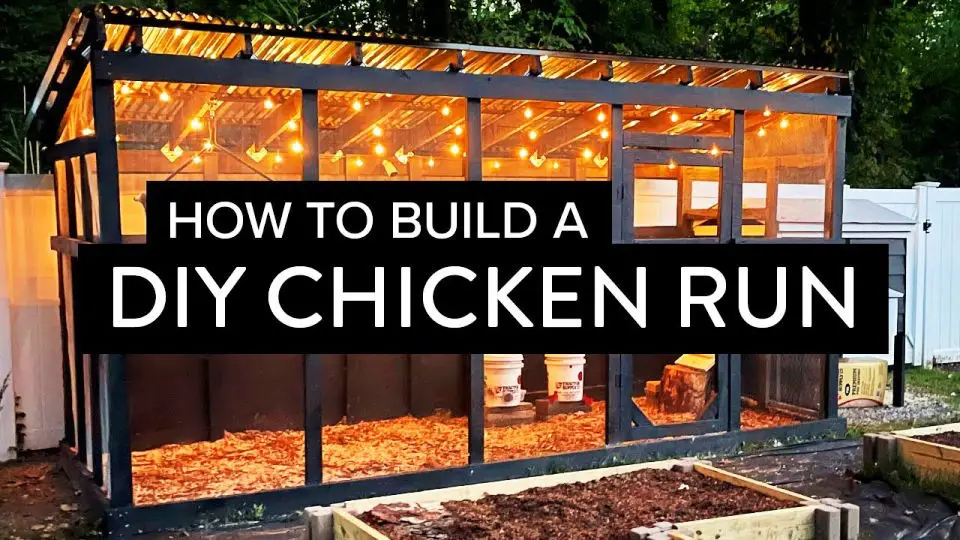
Imagine the satisfaction of building a modern, DIY chicken run that’s both functional and visually appealing. This comprehensive guide will walk you through the process of constructing a 16-foot by 6-foot walk-in coop, using eco-friendly practices like repurposing materials from previous projects. You’ll learn to install rafters, apply a galvanized metal roof, and add a touch of modern flair with paint. The result is not only a safe and spacious haven for your chickens but also an engaging DIY adventure. To complete the project, you’ll discover the benefits of gravel flooring for optimal drainage, topped with hemp shavings for maximum comfort. You’ll also learn to enhance the coop’s functionality with an automatic door and innovative water sensors. With this project, you’ll be rewarded not only with a happy and healthy flock but also with a sense of pride and accomplishment.
Building a Chicken Coop Run
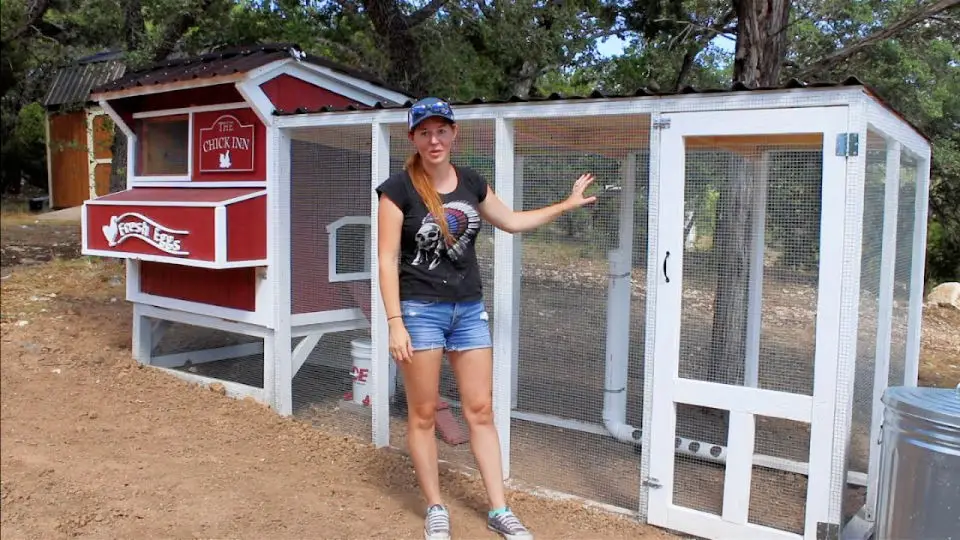
As you strive to provide the ultimate environment for your flock, don’t underestimate the importance of a comprehensive chicken run plan that can withstand various weather conditions. To embark on an exciting DIY adventure, create a modern chicken run that seamlessly blends functionality with style. This guide will walk you through the process of constructing a 16×6 feet walk-in chicken run using eco-friendly materials, including repurposed two-by-fours. You’ll learn how to install rafters, secure a galvanized metal roof, and add a touch of sophistication with paint. The outcome will be a sturdy and attractive enclosure that your chickens will love.In addition to the structure itself, consider the importance of gravel flooring for superior drainage and comfort-enhancing hemp shavings for your flock’s well-being. To further elevate their living conditions, incorporate an automatic door and cutting-edge water sensors into your coop design, ensuring a safe and spacious haven for your feathered friends. By diving into this engaging project, you’ll not only be creating a unique backyard poultry experience but also strengthening the bond between yourself and your flock.
How to Do Chicken Coop Run
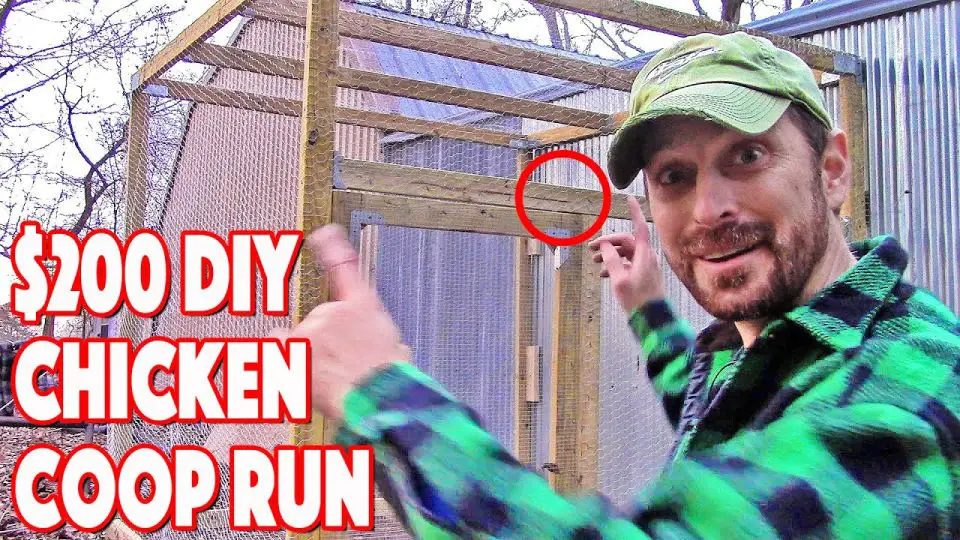
Transform your backyard farming experience with a predator-proof and budget-friendly DIY chicken coop run, crafted by a seasoned Texas homesteader. This comprehensive guide takes you through the construction process of an 8x8x8 foot enclosure using readily available materials like lumber, hardware cloth, and chicken wire. The innovative corner brackets ensure a sturdy structure that’s designed to safeguard your flock from digging predators and aerial threats alike. With step-by-step instructions for framing and wire installation, this project makes building your own backyard haven accessible and rewarding for all chicken enthusiasts. By blending practicality with the joy of DIY, you’ll create a secure and spacious environment for your poultry, elevating your backyard farming experience to new heights.
Easy DIY Chicken Run
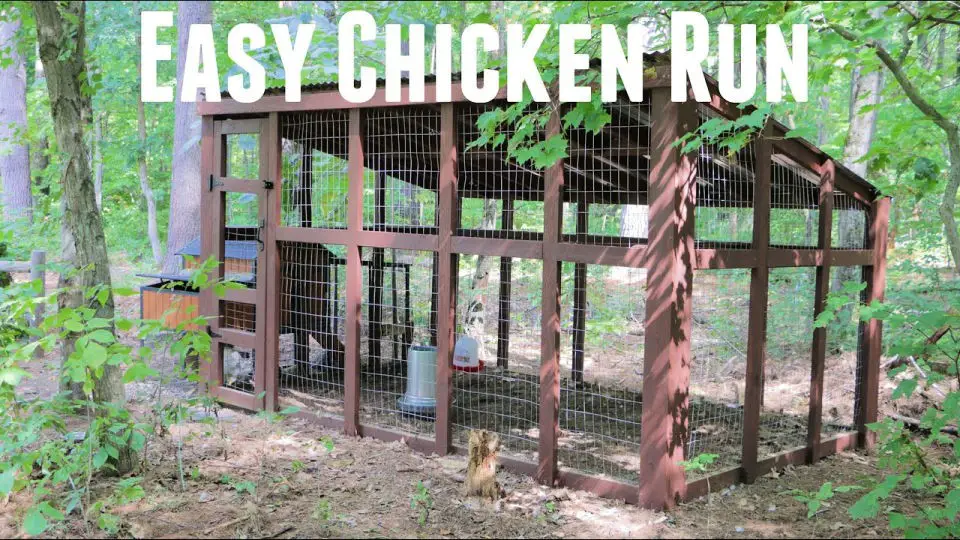
Embark on a journey to create a predator-proof and spacious DIY chicken run that brings joy to both you and your feathered friends. This comprehensive guide walks you through the process of constructing a sturdy structure using pressure-treated lumber, hardware mesh, and metal roofing. From leveling the ground and setting the perimeter to creating a sloped roof and secure mesh foundation, every step is carefully detailed by Tim of Organic Backyard Gardening. The project also includes practical tips on adding a food tray, water station, and cozy perch, not only ensuring your chickens’ safety but also enhancing their quality of life. Perfect for backyard chicken enthusiasts, this DIY endeavor promises a fulfilling experience and a happy, secure home for your beloved chickens.
DIY Outdoor Chicken Run

Transform your backyard into a sanctuary for your hens with a custom DIY Outdoor Chicken Run. This comprehensive guide takes you on a step-by-step journey, transforming a basic yard space into a secure and spacious haven. The project begins with a simple design, then advances to constructing a four-foot tall fence, integrating an automatic chicken door, and installing sturdy hog panels for enhanced safety and security.Throughout the tutorial, emphasis is placed on ease of egg collection and efficient use of space. Durable materials such as quick-setting concrete, rebar, and cabinet screws ensure the structure’s longevity. This practical and cost-effective solution not only triples the outdoor area for your feathered friends but also adds an aesthetic touch to your garden.Ideal for poultry enthusiasts seeking a rewarding weekend project, this DIY Outdoor Chicken Run is the perfect way to elevate your backyard poultry care while providing happy and healthy hens.
Building a Predator-proof Chicken Coop Run
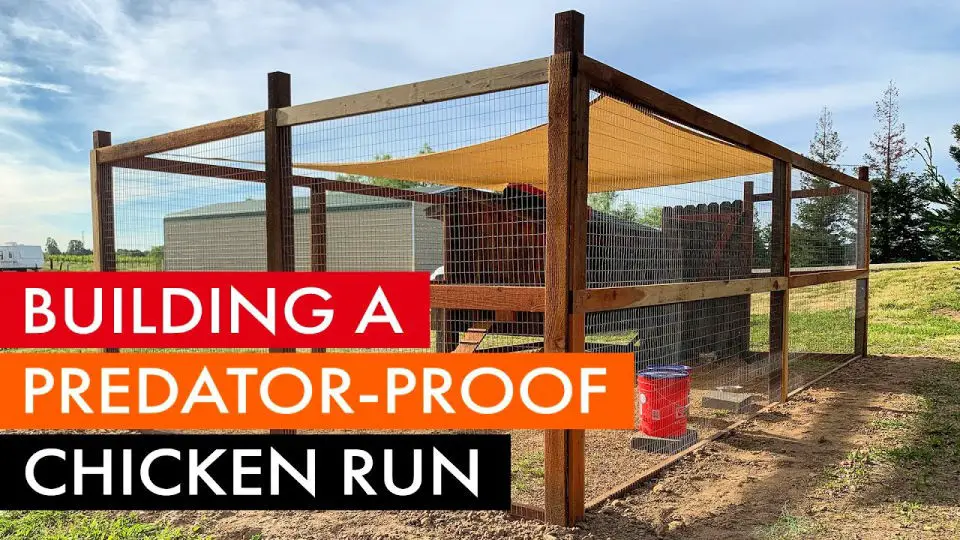
Transform your backyard into a haven for your feathered friends by constructing a robust predator-proof chicken coop run. Follow along with a heartwarming YouTube tutorial that guides you through the process of setting concrete posts, building a sturdy frame, and securing it with ultra-strong wire that outperforms standard chicken wire. To further safeguard your flock, add a wire skirt and top it off with a shaded canvas cover providing both predator protection and relief from the scorching California heat. This engaging DIY project not only guarantees the safety and comfort of your chickens but also cultivates a cherished family bonding experience as you create a secure and cozy home for them.
How to Build a Chicken Coop and Run
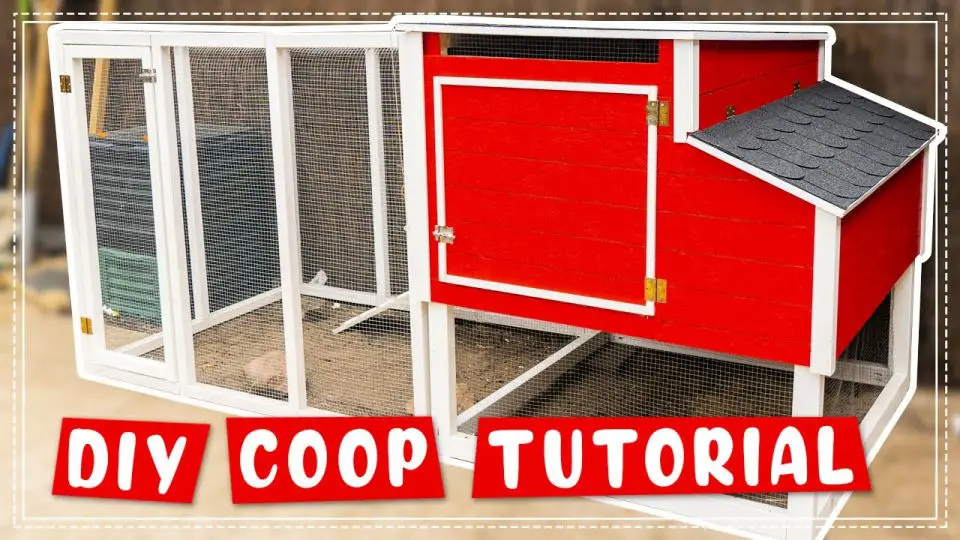
Transform your DIY skills into a fulfilling experience by crafting a customized chicken coop and run that meets the unique needs of your flock and fits seamlessly into your available space. This detailed guide will walk you through every step, from choosing high-quality plywood to constructing a solid foundation using 44x69mm bars or 2x4s. Discover the importance of pre-drilling, wood glue, and precise alignment for a strong structure that will withstand the elements and the antics of your feathered friends. The tutorial also showcases creative solutions like utilizing linoleum for effortless cleaning, sealing crevices to prevent blood lice infestations, and crafting a movable perch. Add a pop of personality with decorative grooves and a fresh coat of paint in a color that suits your style – perhaps the bold Valentine Red. Finally, complete the project by building a secure run, ensuring a safe and comfortable haven for your chickens to thrive.
Easy Chicken Coop Run Tutorial
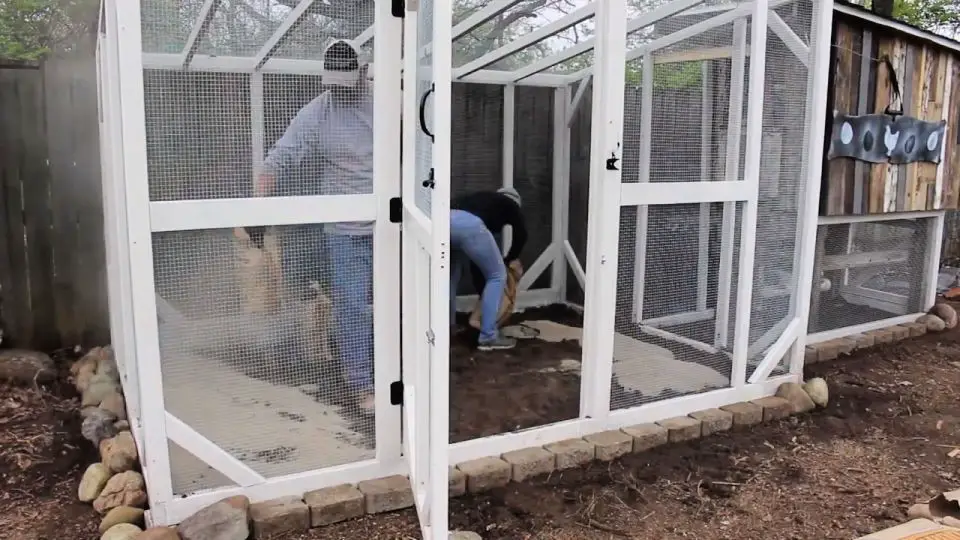
Crafting a functional and sturdy DIY Chicken Coop Run is a rewarding experience for backyard poultry care enthusiasts. This comprehensive guide simplifies the process, starting from scratch with a solid base and progressing to a spacious walk-in structure. The primary materials used are two-by-threes and four-inch lumber, supplemented by essential tools like a nail gun, screws, and an angle grinder. This project strikes a balance between durability and ease of access, ensuring a safe and convenient environment for your feathered friends.
Protection is paramount in any chicken coop run, which is why this design features hardware cloth to deter predators. A clever anti-sag gate kit keeps the structure standing tall over time, while an innovative internal predator apron adds an extra layer of security. To complete the look, landscaping stones and sand are used to create a visually appealing and well-maintained coop run.
This DIY project is perfect for chicken enthusiasts who value practicality as much as they do countryside charm. With its sturdy construction and pleasing aesthetic, this coop run provides a sense of satisfaction and accomplishment that’s hard to find in more traditional backyard projects.
Beautiful DIY Chicken Run
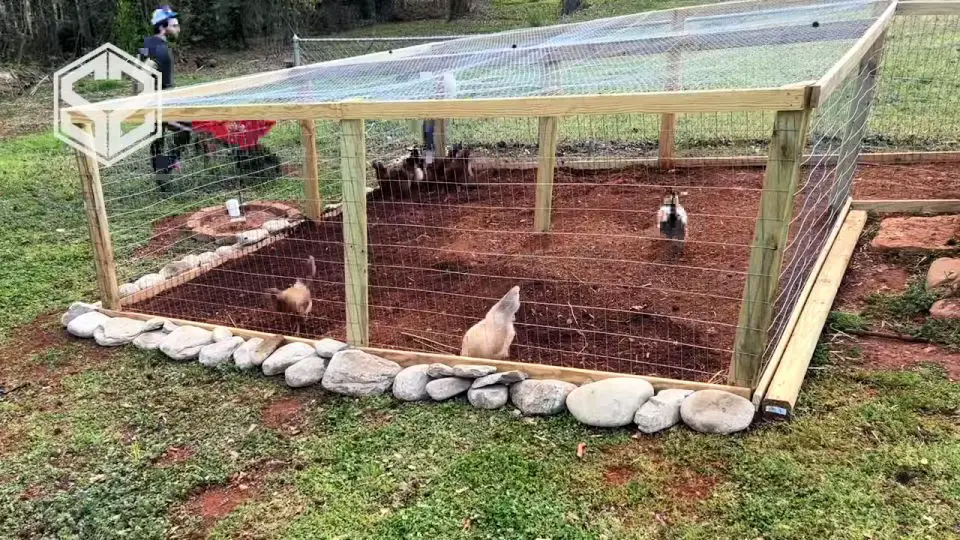
Transform your backyard poultry care by building a DIY Chicken Run, a budget-friendly solution that expands your chickens’ living space. This step-by-step guide shows you how to construct a sturdy, predator-proof enclosure using affordable materials like landscape timbers and deck boards, which provide a cost-effective alternative to expensive lumber. The process involves digging post holes, ensuring the posts are plumb, and securing the area with fencing. Additional safety measures include using chicken wire for smaller openings and reinforcing the structure with boards. This run not only provides ample space for your chickens to roam but also protects them from predators by covering the top and lining the perimeter with rocks. A great project for those looking to upgrade their chicken coop while ensuring the well-being and happiness of their feathered friends.
How to Make a Chicken Coop Run

For a comprehensive guide on building a durable chicken coop run, look no further than DIYfferent’s YouTube tutorial. This in-depth video takes you through every step of the process, from selecting materials to final assembly, ensuring your chickens have a safe and comfortable outdoor space. The tutorial provides a detailed list of necessary items, including pressure-treated lumber, hardware cloth, welded wire, and outdoor screws, providing everything you need to get started.
nThe coop’s design focuses on practicality, attaching seamlessly to a garage and eliminating the need for a separate roof. This not only saves time but also provides shelter from the elements. The tutorial also shares valuable insights on avoiding wood splitting and ensuring stability without relying on concrete.
nIdeal for DIY enthusiasts, this instructional video is designed to help you successfully complete your chicken coop project. With its step-by-step approach and emphasis on practicality, it’s the perfect resource for anyone looking to create a sturdy and functional outdoor space for their feathered friends.
Conclusion:
As you complete your DIY chicken run project, take pride in providing your flock with a safe and inviting space. By thoughtfully choosing the location, gathering essential materials, and following straightforward construction steps, you can create a secure haven for your chickens. This comprehensive guide covers every aspect of building a homemade DIY chicken run, from grasping size requirements to maintaining and protecting it from predators. With 25 custom-made DIY chicken run plans at your disposal, you’re now ready to embark on this rewarding adventure and give your chickens the perfect outdoor retreat.

